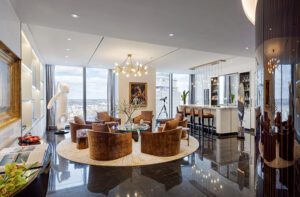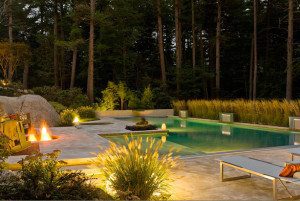Vintage meets Contemporary in Newtown, Connecticut
October 12, 2017
Simple, clean, and decidedly modern, a Newtown home nevertheless pays homage to the farming history of its fourteen-acre site.
Text by Debra Judge Silber Photography by Michael Partenio Produced by Stacy Kunstel
We love farmhouses for the connections they remind us of. Connections to the land. To nature. To a simpler life. Here in New England, connectivity is expressed outright in our rural architecture, in the familiar form taken by rustic homesteads: a house attached to a shed attached to a barn. Simple forms linked together that create an archetype.
“The soul of the whole thing is this concept of simple, connected forms,” Georgetown architect Daniel Conlon says of the formula he used to design what he describes as “a modernist interpretation of a traditional farmhouse.” The result is a timeless building in which hallmarks of farmhouse style—sloped metal roofs, vertical siding, and covered porches—create such a familiar context that unexpected modern elements—an industrial catwalk, a glass curtain wall—seem to belong.
This marriage of vintage and contemporary was exactly what Conlon’s clients, Sian and Robert, were seeking in the new house they planned to build on fourteen acres in Newtown. Robert, a retired businessman with a longtime interest in architecture, was particularly engaged in assembling the couple’s wish list and sharing those aspirations with Conlon, designer Amy Aidinis Hirsch, and builder Mark Olson.
The new house, set on what was once a centuries-old farm, as well as the lifestyle it engendered, would be a marked departure from the family’s previous life in heavily wooded Weston. “Both of us wanted something more open, more of a farm,” says Robert. “We wanted to do things ourselves. We wanted to get in touch with working the land.”
As empty nesters, the couple discovered they enjoyed tackling projects together, and Sian, especially, has found her calling in managing the flora and fauna—which now includes four goats and more than a dozen chickens—that surrounds their new home.
As for the house, “We wanted something very open, very high quality, but not over-complicated,” says Robert. “We came from a house that was trim over trim over trim.”
Conlon responded with a clean, simple design using repetitive forms and common materials applied in thoughtful ways. The sharp angles of the three dormers on the main house perch between the taller, front-facing gables of a garage extension on one side and a master bedroom wing on the other. Corrugated siding on the smaller structures suggests a utilitarian role, but its horizontal orientation introduces a modern edge, as does the twenty-first-century glass curtain wall on the passageway that connects the bedroom wing to the main house. Colors that evoke rural imagery are applied in a way that distinguishes the parts at the same time it unifies them: the sheep-white of the main house is picked up in the trim of the rooster-red garage, which reappears in the window trim of the plow-gray bedroom wing. Standing-seam metal roofing ties it all together.
The house has become one of Conlon’s favorite projects. “I think the appeal comes from stripping down the decoration and letting the volume and concept be the building, rather than making a box and piling trim on it until it looks like something,” he says. “It’s not less detail, but less fussy detail.”
For Hirsch, these elemental details demanded an equally thoughtful, well-edited interior. “The corrugated metal or aluminum windows in themselves are beautiful elements,” she says. “You have to pay attention so you don’t take away from that.”
In a complementary move, she engaged materials as design elements in several areas, including the first-floor bathroom, where she employed the home’s exterior corrugated siding to line a shower stall. Other than installing it vertically rather that horizontally, “there was no need to change it,” Hirsch says. “That’s the beauty of having such a harmonious interior and exterior.”
That harmony is particularly evident inside the home’s two-story great room, where, just inside the front door, an open staircase comprising a steel carriage, reclaimed-wood treads, and cable railings twists up to an open bridge that spans the room above the front door. Beyond the shelter of the bridge, the great room expands upward, with reclaimed barn beams, exposed conduits, and industrial-inspired lighting suggesting that this comfortable space may have originated as a working barn. On the back wall, clerestory windows and French doors open to a south-facing back porch, filtering light into the room.
To the right of the staircase, a hallway, its front wall made of glass, leads to a guest suite that includes a bedroom, sitting room, and bath. Above, the master suite, including a bathroom and generous walk-in closet, fills the second floor. A laundry room and two more bedroom suites reside on the other end of the bridge. Below these, on the first floor, Conlon located the more hardworking spaces: a home office, mudroom, powder room, and dog-wash station (beyond the goats and chickens, the presence of two dogs and two cats put pet-friendliness high on Sian’s wish list).
Rustic beams introduced in the great room extend toward the kitchen, creating a low ceiling that defines the dining area. A wall of cabinets with a pass-through in the center—one of Robert’s must-haves—both separates and links the two spaces.
From a variety of materials under consideration for the kitchen, Hirsch selected a painted ceiling of character-grade oak, ten-inch poplar shiplap on the walls, and white Macaubas quartzite countertops. The gray-blue Shaker-style cabinets have inset doors and simple black pulls that coordinate with the aluminum windows and the metal straps on open shelves that flank the farmhouse sink. While confining the kitchen palette to these mostly traditional materials, Hirsch offset its rusticity with a modern twist—a waterfall countertop on the island made of the same quartzite used on the perimeter.
The designer’s selection of materials that are at once contextual and creative is also apparent in the entry, where a bright slab of deconstructed wallpaper appears to be slowly wearing away. “It’s modern, yet it looks like it’s falling apart a little bit, like it’s been there for some time,” she says. Though Hirsch chose the Petta Thompson paper for its color and texture, it, too, offers its own reminder that the present and the past can connect in unexpected ways, and that the result can be memorable.
Project Team
Architecture: Daniel Conlon, Daniel Conlon Architects
Interior design: Amy Aidinis Hirsch, Amy Aidinis Hirsch Interior Design
Builder: Mark Olson, Olson Development
Landscape and pool design: The LaurelRock Company
Share
![NEH-Logo_Black[1] NEH-Logo_Black[1]](https://b2915716.smushcdn.com/2915716/wp-content/uploads/2022/08/NEH-Logo_Black1-300x162.jpg?lossy=1&strip=1&webp=1)



















You must be logged in to post a comment.